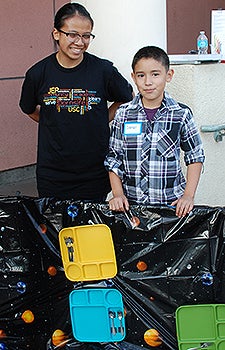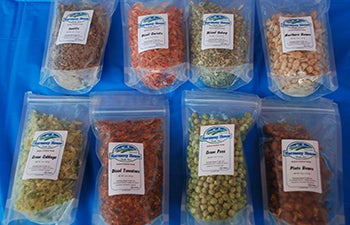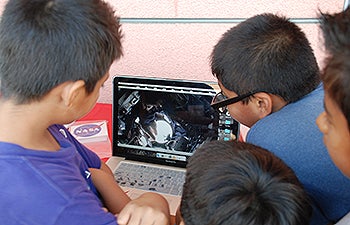Fit as an Astronaut
Freshman Sophia Nguyen demonstrated to fourth and fifth graders how to set a table in space by using Velcro to prevent food packages and trays from floating away.
“Look!” said fifth grader Karla Martinez as she proudly held up a food tray to which she had attached magnets to hold cutlery in place.
Nguyen and Martinez were participating in an after-school studio on health and fitness in space. The studio is an initiative of the Joint Educational Project’s (JEP) Young Scientists Program (YSP) partially funded by USC and JEP alumni donors Michael and Cindy Winn. It was held at Norwood Street Elementary School near USC University Park campus on Nov. 10.
“I signed up to do the workshop today because I wanted to learn about what astronauts eat and how they stick their food packages to their plates,” said Martinez, adding that she wants to be an astronaut when she grows up.
“Today I learned that astronauts float without their shoes because they don’t need to wear them in the space station. But my favorite part was the exercising station because you get to use weights to be strong.”
Nguyen said she is excited to be a part of YSP.
“I didn’t get opportunities like this as a kid and I want to share and give back,” said Nguyen, a human biology major at USC Dornsife.

Fourth-grade student Daniel Garrido with Young Scientists Program teaching assistant Sophia Nguyen, a human biology major at USC Dornsife, who helped him figure out how to set a table in space.
Funded by a grant from the Safeway Foundation, the activities at the health and fitness workshop were the brainchild of Dieuwertje “DJ” Kast, STEM programs manager for YSP and WonderKids at JEP.
“I wanted to approach health and fitness from a different perspective because I feel many students already know about healthy eating and exercising,” Kast said. She came up with the idea to marry health and fitness with science by concentrating on health and fitness in space.
“We want kids to ask themselves: are you fit enough to be an astronaut? How do you eat healthily in space when you can’t grow your own vegetables and you have to bring up all your own food? Did you know astronauts tend to lose muscle mass and bone density in space because of lack of gravity? Or that astronauts have to exercise for two hours a day but still have to go through rehab when they return to Earth?”
Students learned the answers to these questions and many more as they rotated among seven stations, each with a different theme. At each station, students watched a video of an astronaut doing a particular activity in space, then tried to perform the task themselves. Also at each station, a YSP teaching assistant majoring in science at USC was on hand to lead the activities and answer questions.
Children started off by learning about the International Space Station and how it supports life. They watched a video in which Sunita Williams, the station’s commander, gave a guided tour of the facility, showing how astronauts in space exercise and peer through a special window that allows them to look down on Earth. They even learned how astronauts go to the bathroom by using specially adapted toilets.
At a space food station, students learned how astronauts eat healthy dried foods that can be preserved in space for up to 18 months. They learned how to rehydrate dried food and sampled astronaut ice cream.

Students learned that astronauts have to rehydrate dried foods such as these to obtain nourishment in space.
At the food transport station, students learned how to use vacuum sealers to preserve food for the voyage into space.
At the sleep station, students talked about the importance of getting a good night’s sleep. They built a sleeping chamber for inflatable astronaut dolls by hooking blankets on to the side of a cardboard box to make mini-sleeping bags.
Students then got to try out exercising like an astronaut at a cardio station and a weight resistance training station.
“They lift real weights and compare that to ‘pool noodle’ weights so students can understand how weights that are heavy on Earth won’t weigh much at all in space because of the lack of gravity,” Kast said. “We have a biking station and students also do the 50-yards-dash. They learn that because there is nothing holding them down, astronauts have to have a harness to hold them when they run and bike.”
Fourth grader Daniel Garrido particularly enjoyed the exercise stations.
”Today I learned that activities we do easily on Earth, like riding a bike, are much harder in space because there is no gravity,” he said. “I also learned it’s really bad for astronauts to go into space because when they are floating around they don’t use their legs and when they don’t use their muscles, they get weaker.”
Garrido said he wants to be an astrophysicist.
“The thing I like best about science is the process of finding answers, like going through my hypothesis,” he said. “I especially like it when I get it wrong because then I have to think how can I improve my theory to get the right answer.”
About three years ago, JEP expanded the YSP program by introducing after school studios to focus on topics that captured the children’s imagination but were unable to be covered in depth in the classroom because of a lack of time, said Tina Koneazny, associate director of JEP.

Children watch a video in which Sunita Williams, commander of the International Space Station, demonstrates how astronauts keep healthy in space.
“Kids who are participating in YSP sign up for these after-school studios so they can really delve into a particular area of science that interests them.”
At the space food station, junior Geoff Kusaka, a human biology major at USC Dornsife and a teaching assistant with YSP, demonstrated how astronauts must rehydrate dried food by adding water to it in order to eat.
“We want the kids to understand how zero gravity will change their entire lifestyle in space,” he said. “It’s wonderful that YSP brings a passion for science to schools around USC where kids might not otherwise get so much science instruction.”
Kusaka said participating in YSP has helped him with public speaking.
“I get to practice my communication skills, which is valuable for whatever I want to do,” he said, referring to the skills he learns speaking before a class of children, their teachers and sometimes their principal four times a week. “YSP has also given me a new appreciation for science now that I’m teaching it.
“I love seeing the look on the kids’ faces when they really enjoy an experiment,” Kusaka said. “It’s incredibly rewarding to see how they improve every week and how much interest they have. I love science and I hope I can instill that passion in these students.”